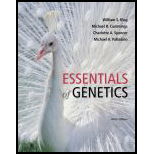
What are the major mechanisms of epigenetic genome modification?
To review:
The major mechanisms of the modification of epigenetic genome.
Introduction:
Epigenetics is a branch of genetics, which studies the changes in the body that are heritable. These changes do not change the DNA (deoxyribonucleic acid) of the organism. The traits that are of epigenetic origin are stable and inherited mitotically as well as meiotically. Thus, these changes bring about changes in the gene expression, without modifying the DNA.
Explanation of Solution
The genome is similar in all the cells of an organism. On the other hand, the epigenome is specific for a cell or varies from cell-to-cell. The traits within the epigenome are transferred to the daughter cells through mitosis and to the offspring by meiosis. The various mechanisms of epigenetic genome modification are described as follows:
1. DNA methylation or demethylation- During transcription, the DNA is methylated at the cytosine. When this methylation or demethylation is reversible, it leads to epigenetic genome modification.
2. Chromatin remodeling- Chromatin is the dense and compact form of DNA, which is bound by the histone proteins. This structure, present within the nucleus is known as a nucleosome. The histone molecule is made up of smaller subunits, which gives it an octameric structure. When the chemical groups are changed attached to the histone proteins, it can lead to epigenetic genome modification.
3. Noncoding RNA (ribonucleic acid) molecules-based gene expression regulation- The micro RNA (miRNAs) and long noncoding RNAs (lncRNAs) are produced during transcription besides mRNA (messenger RNA). The miRNAs control the pattern formation within the developing embryos, physiological processes, and time of development. On the other hand, the lncRNAs bring about epigenetic changes by modifying the chromatin enzymes.
Thus, the epigenetic genome can be modified by three mechanisms, which are reversible DNA methylation or demethylation, chromatin remodeling, and regulation of gene expression by the noncoding RNAs.
Want to see more full solutions like this?
Chapter CHST1 Solutions
Essentials of Genetics (9th Edition) - Standalone book
- Explain how the hormones of the glands listed below travel around the body to target organs and tissues : Pituitary gland Hypothalamus Thyroid Parathyroid Adrenal Pineal Pancreas(islets of langerhans) Gonads (testes and ovaries) Placentaarrow_forwardWhat are the functions of the hormones produced in the glands listed below: Pituitary gland Hypothalamus Thyroid Parathyroid Adrenal Pineal Pancreas(islets of langerhans) Gonads (testes and ovaries) Placentaarrow_forwardDescribe the hormones produced in the glands listed below: Pituitary gland Hypothalamus Thyroid Parathyroid Adrenal Pineal Pancreas(islets of langerhans) Gonads (testes and ovaries) Placentaarrow_forward
- Please help me calculate drug dosage from the following information: Patient weight: 35 pounds, so 15.9 kilograms (got this by dividing 35 pounds by 2.2 kilograms) Drug dose: 0.05mg/kg Drug concentration: 2mg/mLarrow_forwardA 25-year-old woman presents to the emergency department with a 2-day history of fever, chills, severe headache, and confusion. She recently returned from a trip to sub-Saharan Africa, where she did not take malaria prophylaxis. On examination, she is febrile (39.8°C/103.6°F) and hypotensive. Laboratory studies reveal hemoglobin of 8.0 g/dL, platelet count of 50,000/μL, and evidence of hemoglobinuria. A peripheral blood smear shows ring forms and banana-shaped gametocytes. Which of the following Plasmodium species is most likely responsible for her severe symptoms? A. Plasmodium vivax B. Plasmodium ovale C. Plasmodium malariae D. Plasmodium falciparumarrow_forwardStandard Concentration (caffeine) mg/L Absorbance Reading 10 0.322 20 0.697 40 1.535 60 2.520 80 3.100arrow_forward
 Principles Of Radiographic Imaging: An Art And A ...Health & NutritionISBN:9781337711067Author:Richard R. Carlton, Arlene M. Adler, Vesna BalacPublisher:Cengage Learning
Principles Of Radiographic Imaging: An Art And A ...Health & NutritionISBN:9781337711067Author:Richard R. Carlton, Arlene M. Adler, Vesna BalacPublisher:Cengage Learning Human Heredity: Principles and Issues (MindTap Co...BiologyISBN:9781305251052Author:Michael CummingsPublisher:Cengage Learning
Human Heredity: Principles and Issues (MindTap Co...BiologyISBN:9781305251052Author:Michael CummingsPublisher:Cengage Learning Biology (MindTap Course List)BiologyISBN:9781337392938Author:Eldra Solomon, Charles Martin, Diana W. Martin, Linda R. BergPublisher:Cengage Learning
Biology (MindTap Course List)BiologyISBN:9781337392938Author:Eldra Solomon, Charles Martin, Diana W. Martin, Linda R. BergPublisher:Cengage Learning Biology Today and Tomorrow without Physiology (Mi...BiologyISBN:9781305117396Author:Cecie Starr, Christine Evers, Lisa StarrPublisher:Cengage Learning
Biology Today and Tomorrow without Physiology (Mi...BiologyISBN:9781305117396Author:Cecie Starr, Christine Evers, Lisa StarrPublisher:Cengage Learning Human Biology (MindTap Course List)BiologyISBN:9781305112100Author:Cecie Starr, Beverly McMillanPublisher:Cengage Learning
Human Biology (MindTap Course List)BiologyISBN:9781305112100Author:Cecie Starr, Beverly McMillanPublisher:Cengage Learning Biology: The Dynamic Science (MindTap Course List)BiologyISBN:9781305389892Author:Peter J. Russell, Paul E. Hertz, Beverly McMillanPublisher:Cengage Learning
Biology: The Dynamic Science (MindTap Course List)BiologyISBN:9781305389892Author:Peter J. Russell, Paul E. Hertz, Beverly McMillanPublisher:Cengage Learning





